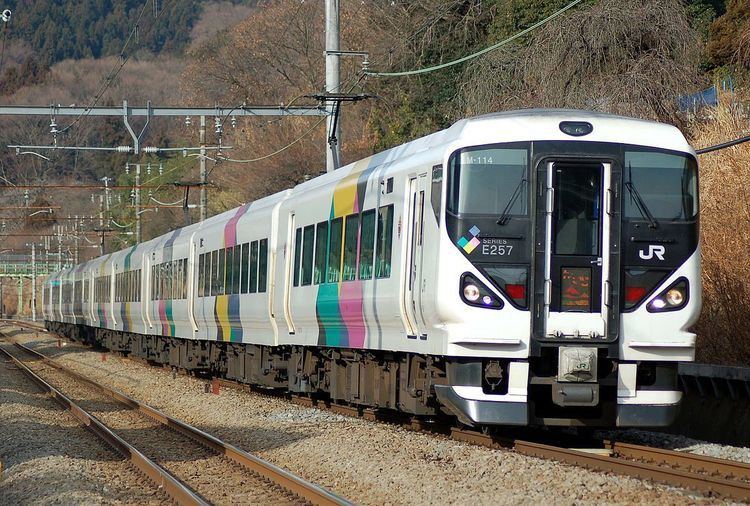Former operator(s) JNR | Status Operational Current operator(s) JR East | |
 | ||
First service 1 October 1961 (Semi express)12 December 1966 (Express)13 March 1988 (Limited express) | ||
The Kaiji (かいじ) is a limited express train service in Japan operated by East Japan Railway Company (JR East). It runs mainly between Shinjuku Station in Tokyo and Kōfu Station in Kōfu, Yamanashi via the Chūō Main Line.
Contents
Kaiji
Shinjuku - Kōfu (Some trains operate between Tokyo and Ryūō.)
View Kaiji
Chiba - Kōfu - Ryūō
Hamakaiji
Yokohama - Hachiōji - Matsumoto
Kaiji
From 2016, new EMUs are scheduled to be introduced on Kaiji services, replacing the E257 series trains. The new trains will feature power outlets for passenger use and WiFi internet service.
View Kaiji
Hamakaiji
E257 series Kaiji
Most Kaiji (E257 series) services are formed of nine cars, numbered 3 to 11, with car 11 at the Kofu end. Cars 1 and 2 are added to some trains.
185 series Hamakaiji
The seasonal Hamakaiji services are formed of 7-car 185 series EMUs based at Tamachi Depot in Tokyo, with car 1 at the Yokohama end.
Semi-express
The Kaiji service began on 1 October 1961 as a semi express operating between Shinjuku and Kōfu. The name was derived from the old name, Kai (甲斐), of Yamanashi Prefecture. Services were operated using KiHa 58 series diesel multiple unit (DMU) trains in between duties on long-distance Alps and Hakuba express services. DMUs were used on these services due to the restricted tunnel clearances along the line prohibiting the use of electric trains. The outbound service departed from Shinjuku at 14:50, arriving at Kōfu at 17:19. The return working departed from Kōfu at 18:28, arriving at Shinjuku at 21:20. The Kaiji services were however discontinued and integrated with the Alps express services from the start of the revised timetable on 1 October 1965 when electric trains were introduced.
Express
The Kaiji name was revived from 12 December 1966 for use on express services aimed at business users, operating between Shinjuku and Matsumoto using 12-car 165 series EMU formations in between duties on longer-distance Alps services. The early morning up working departed from Matsumoto at 04:50, arriving at Shinjuku at 09:34. The evening down service departed from Shinjuku at 18:55, arriving at Matsumoto at 23:36. From the start of the 1 October 1968 timetable revision, the Shinjuku - Matsumoto service was integrated with the other Alps express services also operating between Shinjuku and Matsumoto, and the Kaiji name was used for five new return express services operating between Shinjuku and Kōfu. Due to the seasonal nature of ridership on these services, three of the five return workings were designated as seasonal services, operating only during peak seasons. These services were operated using outer-suburban 115 series EMUs, whereas the two regular services were operated using 165 series express EMUs with first-class accommodation and buffet facilities. In response to the lack of first class accommodation, a 115 series set reformed with a 165 series "SaRo 165" Green car was used on some services. The use of suburban rolling stock on express services requiring payment of a supplement was not popular, however, and the seasonal services were downgraded to "Rapid" services by 1978, leaving just the two regular Kaiji express services using 165 series rolling stock. The remaining Kaiji services were discontinued from the start of the 1 November 1986 timetable following the introduction of new Azusa limited express services.
Limited express
From 13 March 1988, five of the Azusa limited express services operating between Shinjuku and Kōfu were expanded to nine return workings daily and renamed Kaiji. Initially operated using 6-car 183 series EMUs, all Kaiji services were operated using 9-car sets from the start of the December 1993 timetable revision. These were lengthened to 11-car sets from October 1997.
Smoking was prohibited in all cars from 18 March 2007.
